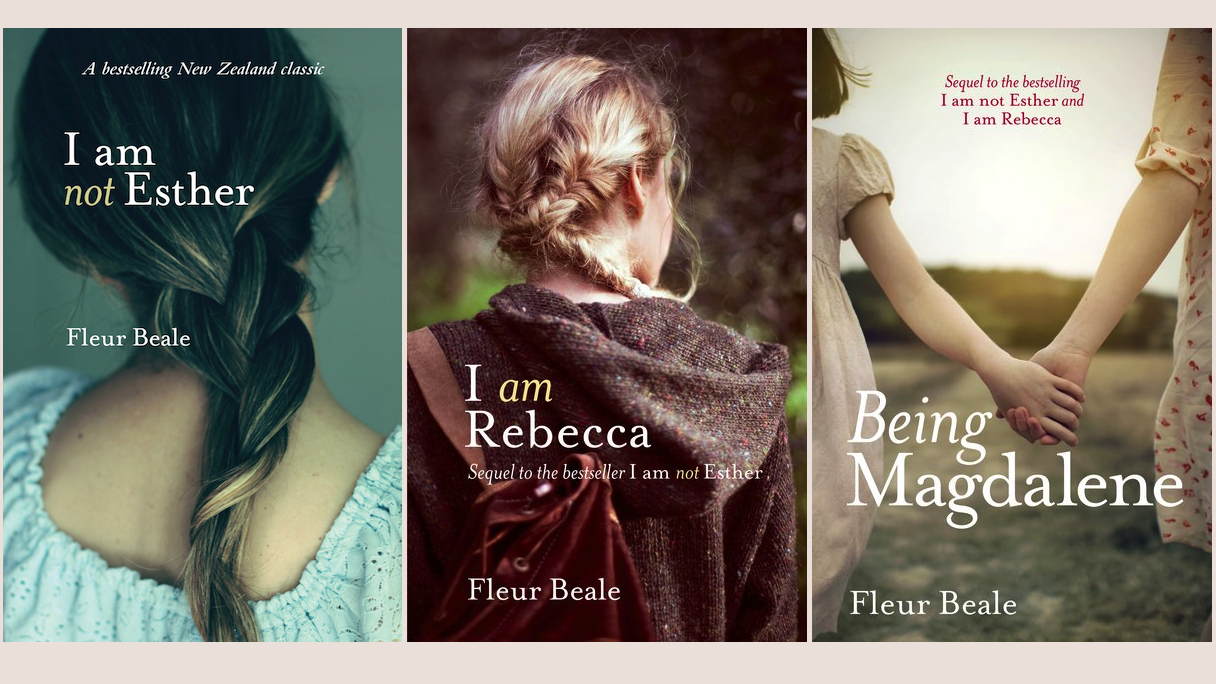Gem Wilder shares her journey into the world of the Children of the Faith in Fleur Beale’s beloved trilogy: the stories of Kirby, Rebecca, Magdalene and so many more young women (and men) who are fictional… but easily could be real too.

I’ve always been drawn to media that examines spirituality and religion, that tells of rituals, sects, societies and cults, and I don’t think I’m alone in this. Think of the many articles about Scientology that have been written, of how alluring the secrecy of what goes on behind closed doors can be. A massive growth in interest in true crime stories has been taking place, and a renewed interest in cults seems to be related. There are podcasts about self-described multi-level marketing company NXIVM and novels about Jonestown and The Peoples Temple – not to mention the success of the television series based on Margaret Atwood’s The Handmaid’s Tale and multiple documentaries about New Zealand’s own Gloriavale.
In fiction for young people, we have Fleur Beale’s trilogy about the Children of the Faith. Like Gloriavale, this fictional sect is New Zealand-based, and Beale’s in-depth research into that self-described ‘Christian community’ can be seen in her work. The first book in the young adult series, I Am Not Esther, was first published in 1998, followed by I Am Rebecca in 2014 and Being Magdalene in 2015.
I found I Am Not Esther on the shelf of a second hand bookstore in the early 2000s, when I was in my twenties. The title caught my eye first, and then the cover image of a young woman peering out through a cross. It appealed to me immediately. When I found out about its sequel I headed along to the launch at The Children’s Bookshop in Kilbirnie. It was a joint launch, and while I was milling around waiting on the formalities to begin, Fleur Beale herself wandered up to me and asked who I was there for. ‘You!’ I squeaked, a little awestruck. I purchased my copy of I Am Rebecca, had it signed by the author, and took it home to devour.
Fleur Beale herself wandered up to me and asked who I was there for. ‘You!’ I squeaked, a little awestruck.
I also began evangelising about these books to others. I passed them on to my family, who took turns reading them and passing them from person to person. The trilogy made it through two of my sisters, my mother, and a nephew and niece, all of us enthralled by the quality of storytelling, and the authenticity and complexity of Beale’s characters and the situations they find themselves in.
The books are described as psychological thrillers, and thriller is right. They had me reading with bated breath, anxiously following the fates of each of their narrators. The first book tells the story of Kirby Greenland, a typical Auckland teenager living with her mother. One day, completely out of the blue, Kirby’s mother announces she is going to Africa to work as a nurse, and Kirby is to live with her uncle and his family in Whanganui. She has never known she has extended family, her mother having left the Children of the Faith at age 16 and never speaking of that part of her past.
They had me reading with bated breath, anxiously following the fates of each of their narrators.
And so Kirby is thrust into a world that is completely alien to her, where she is given the biblical name Esther, made to wear ‘modest’ clothing, and suffers, along with the rest of her adoptive family, hours long sessions of kneeling on the hard wooden floor while patriarch Uncle Caleb prays over them. There are other cruel punishments that Kirby must deal with, but the beauty of this book is in the relationships she forms: with her ‘new’ family, with other girls her age of the Faith, and with her school guidance counsellor.
You get a real sense throughout this book that Kirby is in a hopeless situation. She has no idea where her mother is, and no way of contacting her. She is stuck, and Beale has done an excellent job of illustrating the effect the upheaval has on Kirby’s mental health. We also see that the situation is hopeless not just for Kirby, but for those born within the Faith who feel torn between the life they want to live, and the family, faith and community that form their lives – like her cousin/adoptive brother Daniel.
We also see that the situation is hopeless not just for Kirby, but for those born within the Faith who feel torn between the life they want to live, and the family, faith and community that form their lives…
I Am Rebecca is my favourite of the trilogy. It’s narrated by Rebecca, younger sister of Daniel and cousin of Kirby, one of the eight Pilgrim children. The story begins roughly four months after the conclusion of I Am Not Esther, and is particularly interesting because Rebecca is an identical twin. My sister said of I Am Rebecca: ‘[It was an] interesting take when [Beale] had the twins head off in different directions. It was a clever way to illustrate how it’s harder for some, and others just slot in.’
I Am Rebecca also had a twist that shocked me. I won’t go into the details, but my sister agreed, calling it ‘totally shocking.’ She said ‘You felt her shock, and even her mother was shocked, and you felt that intense fear.’ This was the benefit of having a naïve narrator who has been told all her life that the faith keeps her safe, while at the same time she is constantly finding herself in situations that contradict this.
This was the benefit of having a naïve narrator who has been told all her life that the faith keeps her safe…
By the end of the third book, Being Magdalene, we’ve run the gamut of emotions and experiences, including nervous breakdowns, physical violence, exile, post-partum depression, hints at tax fraud, child abuse, rape, emergency calls to police and ambulances, and parents who put their standing in the church ahead of the welfare of their children. There are people trying to do good with the limited means accessible to them, there are people deliberately taking advantage of a twisted system, there’s intrigue and friendship and love and community. It all feels incredibly real; the trilogy could easily be the origin story of a community like Gloriavale.
We asked my 15-year-old niece what she thought of I Am Not Esther and what she would do in Kirby’s situation, and she was adamant in her response. ‘If I was her I’d be like stuff* that.’ This response, as much as anything, brought home to me the shocking reality of Kirby’s situation, and that of Rebecca and Magdalene after her, as well as so many of the other young people in the stories. As headstrong as my niece is, as capable and smart and sassy and confident, she’d still be in a hopeless situation where her refusal to live by someone else’s extreme and irrational rules would result in cruel punishments. She would be trapped, her spirit would likely be broken.
Beale doesn’t shy away from broken minds and spirits in her trilogy. She draws portraits of young women who have been irrevocably harmed by their experiences, but who work to find ways to live fulfilling lives. One thing the trilogy makes clear is that no one can get through hard experiences alone. Community is important, and some of the members of the Children of the Faith find their support system within their church. Others need to find a new support system. And there are no miracle cures to damaged mental health, no quick fixes. Instead, Beale has painted a brilliant and realistic story that is fascinating and thrilling not just for young adults, but for much older readers too.
*not the exact word she used.

Gem Wilder
Gem Wilder is a Wellington writer whose work has been published in and performed at many places, including The Spinoff, The Sapling, Sport, Is It Bedtime Yet?, Enjoy Gallery, The Dowse, Wellington Museum, and LitCrawl.



